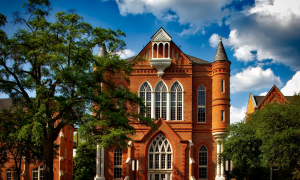Higher education building construction escalated during the 1960s to accommodate the wave of baby boomers entering college. These aging buildings now represent 40 percent of the space on college and university campuses. Many of these structures need either extensive repairs and remodeling or replacing.
According to Mark Schiff, president of Sightlines, many colleges and universities are choosing to add new buildings to their campuses instead of renovating old structures. In part, the choice to build over remodel is in hopes of boosting lagging enrollments, staying competitive, and enriching the campus experience by constructing state-of-the-art student unions, dining halls, and other buildings. Another reason for selecting new construction over remodeling is the enormous expense of retrofitting the old campus buildings so they are environmentally compliant, energy-efficient, safe, and durable.
Today’s higher education buildings must also aim to provide a healthy and acoustically pleasant environment for the protection, comfort, and productivity of the students and teachers. Notably, a 2014 study by Harvard proved the importance of excellent indoor environmental quality (IEQ). The study concluded that cognitive function test scores doubled in buildings with improved IEQ.
Construction Methods of the 1960s Mandate Replacement, not Refurbishing, of these Higher Education Buildings

Building methods of the 1960s did not accommodate many of the features now demanded of higher education buildings. Because of the cost to bring these old higher education buildings up to modern standards, many campus leaders are choosing new construction over remodeling. Six construction trends for higher education buildings include energy-efficiency, good IEQ, durability, disaster-resistance, utilizing the design-build method, and implementing multipurpose and flexible room design.
-
Energy-Efficient Higher Education Buildings
The energy-efficient design of higher education buildings requires continuous insulation (CI) and high thermal mass products. Energy-efficiency is essential in controlling the long-term expenses of a college or university. Notably, campus buildings consume more than 80 percent of the energy used by the universities. Improving energy efficiency can cut campus energy use up to 60 percent. Moreover, reducing energy use is good for the environment because it decreases carbon dioxide emissions.
-
Higher Education Buildings with Excellent IEQ
Good IEQ improves the comfort, safety, and productivity of the building’s occupants. IEQ elements include proper ventilation, maximizing daylighting, mold resistance through moisture control, optimizing acoustic performance, and avoiding the use of materials like formaldehyde and high-volatile organic compounds.
Exposure to mold is harmful because it can cause throat irritation, wheezing, coughing, eye irritation, or skin irritation. Formaldehyde exposure is unhealthy, particularly to those with pre-existing breathing conditions, like bronchitis and asthma.
-
Durable Higher Education Buildings
Durability is vital for controlling the long term expenses of educational buildings. Essential to durability is stopping moisture accumulation within the building’s envelope. Moisture can lead to rot, which degrades a building’s integrity and can lead to costly repairs.
Termite-resistance is also critical for preserving the integrity of the structure and preventing costly long-term repairs.
-
Disaster-Resistant Higher Education Buildings
Disaster-resistant design is critical for protecting a higher education building and its occupants from dangerous natural catastrophes. The disaster-resistant design also saves universities and colleges on costly repairs after a severe natural disaster.
-
The Design-Build Method for Constructing a Higher Education Building
Design-Build is a construction method in which university officials work with a design-team (builder and architect), that work together under a single contract.
A benefit of design-build for the university is there is only one contract to manage and one responsible party, the design team. The design-build method can also result in faster completion of projects with fewer change orders than the design-bid-build method; which saves the university money.
-
Design Trends of a Higher Education Buildings
Today’s higher education buildings are multipurpose. Multipurpose buildings allow for many activities under one roof: studying, exercise, dining, recreation, etc. Higher education building design also includes flexible classroom and meeting spaces that expand and contract as needed for various classroom and events sizes.
Barricade’s Thermo-Brace® S.I.B. – an Excellent Sheathing for New Higher Education Buildings

Barricade Thermo-Brace® S.I.B Lessens Higher Education Building Construction Costs
Thermo-Brace® S.I.B. provides stable market pricing and can save up to 30 percent install costs over OSB. Barricade Thermo-Brace® S.I.B. further saves money by decreasing labor time and reducing the risks associated with building errors and environmental damages.
Thermo-Brace® S.I.B. produces energy-efficient higher educational buildings:
- Thermo-Brace® S.I.B. will provide CI for a higher educational building.
- Thermo-Brace® S.I.B. has superb long-term thermal resistance and is available in R-5 and R-3 thicknesses.
- Importantly, Thermo-Brace® S.I.B. meets the 2018 International Energy Conservation Codes for continuous insulation sheathing and has nearly ten times the insulative value of OSB, which will save universities money on long-term expenses.
Barricade Thermo-Brace® S.I.B. Helps Create Durable Higher Education Buildings
Thermo-Brace® S.I.B. has a weather-resistant barrier on both sides of the panel which provides superior moisture management and mold resistance, which contributes towards a durable building and saves universities money on costly repairs due to rot.
Barricade Thermo-Brace® S.I.B. Contributes Towards Disaster-Resistant Higher Education Buildings
Thermo-Brace® S.I.B., with alternative corner bracing and high structural ratings, produces strong higher education buildings that resist lateral forces of wind, storms, and earthquakes.
Barricade® Thermo-Brace® Structural Insulative Board (S.I.B.) creates energy-efficient, durable, safe, and healthy higher education buildings. Thermo-Brace® S.I.B also saves universities and colleges money because it decreases construction labor time and reduces job site risks and accidents. Thermo-Brace® S.I.B. further saves on long-term expenses because it is energy-efficient, durable, and resistant to wind and earthquakes.







